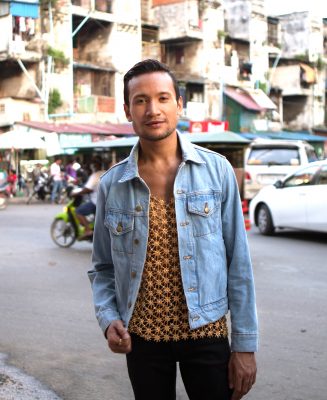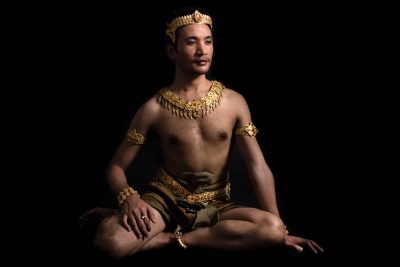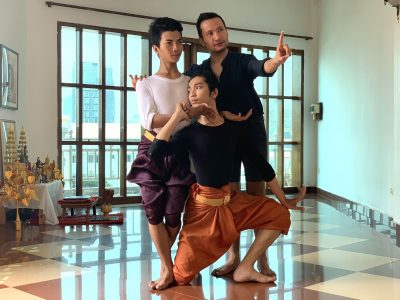A slender silhouette festooned with flowers tumbling down a curved back appears from the wings and gracefully dances downstage. The bejeweled costume glimmers in the spotlights, and bangles grace the lithe wrists of extended arms. Fingers gracefully curve in a gesture exemplifying Cambodian classical dance.
Performed for centuries, these apsara dances are among the country’s most cherished arts, customarily performed by females entertaining royalty within the sacred city of Angkor. Some 1,800 images of the ethereal apsara (beautiful spirits of the water and clouds) are carved in the stone edifices of Angkor’s many temples.

In an earlier era, roles were mainly performed by men, but around 1843 when King Ang Duong returned from Bangkok, he began dividing male and female dancers into separate troupes. Eventually, male troupes disappeared altogether.
Here on this stage, these six performers are all men, part of Cambodia’s first gay dance company, Prumsodun Ok & NATYARASA. “We wanted to give new life to this ancient dance form by preserving what was given to us and to re-imagine that tradition, create new works, new costumes, and new dances,” explains the troupe’s 32-year-old leader, Cambodian-American, Prumsodun Ok, or Prum. “Through this process we create a new face of Cambodia, one that goes beyond genocide, beyond poverty, and beyond tragedy. Yes, that history still affects Khmer people, but that’s not all we are.”

Prumsodun Ok
Khmer dance, embodying animist, Hindu, and Buddhist philosophies, developed as a dynamic prayer for rain and fertility. Dancing bodies carry their desires up to the heavens through hand gestures and curvilinear motions, invoking both serpents and the flow of life-giving rivers, ensuring the well-being of the land and people.
When Prum was four, he became captivated by videos his father filmed at the local temple in Long Beach, California, and Prum would imitate the dances while costumed in his sister’s dresses. As he got older, in order to hide his femininity and budding sexuality, he distanced himself entirely from dance. But when he was 16 he followed his sisters to their Khmer dance lessons and his love for the sinuous movements, transforming music, and glimmering costumes was rekindled. After a year on the sidelines Prum finally struck up the courage to ask the teacher if he could study Khmer.
In 2015, after years of teaching dance at the Khmer Arts Academy in Long Beach, Prum started to feel trapped and frustrated. Getting older, he knew that his time as a dancer was limited, and the audiences for his shows was largely friends and other artists, and his work never got beyond the “art ghetto.”
He resigned from his teaching position, and, as luck would have it, shortly after he received a grant for a project called Beloved. Inspired by a 13th century tantric ceremony, the show depicts the Khmer king sexually uniting with a naga (sacred serpent) and taking the form of a woman to ensure prosperity.

Prum’s version of Beloved utilized the dancing bodies of gay men (deemed by many Cambodians to be illicit and contrary to nature) to portray a love so powerful that it makes rain fall. Two months into rehearsals Prum suddenly realized that Cambodia’s first gay dance troupe had materialized in his living room.
“A big shift occurred when I recognized myself as a center,” Prum said. “I am a being with the power to draw diverse forces together, and live between many different cultures, communities, histories, and approaches. Instead of trying to place myself in a spectrum, I contained the spectrum inside me. And, suddenly, my struggles became a richness.”
In restaging Khmer classical dance, Prumsodun Ok & NATYARASA had two missions: To revitalize and bring global attention to an art form that was nearly obliterated in the genocide by the Khmer Rouge, which murdered one third of Cambodia’s population, and to use the ancient dance to create new works centering on LGBTQ+ characters and perspectives to elevate their quality of life and expression.
“By training young gay men and creating dances that reflect my own experience, I am offering new bodies, new ideas, and new ways of being of value to our traditions. And I am giving an often misunderstood and stigmatized community a chance to be celebrated as caretakers of heritage.”

Initially, Prum felt some resistance among his own dancers, but slowly they grew to trust him and eventually built a community around their love for dance.
One of the recent members of the troupe, Pichoudom Phun, is following in the footsteps of his grandmother who performed classical dance for Cambodia’s kings at the royal palace. The 22-year-old says he is proud to be championing the art and promoting LGBTQ visibility and rights.
Though Prum and his troupe have received threats of violence, people are often surprised to hear that he generally feels safer as a gay man in Cambodia than in the United States. Yet, he is still aware of the struggles: being forced to marry someone of the opposite sex, children being disowned, and many facing job discrimination. But he also knows of parents who are loving and accepting.
“When I was younger, my parents tried their best to stop me from dancing. After living in poverty and surviving war and refugee camps, my parents saw my academic excellence as a promise out of struggle. For them, dance meant a life of pain and poverty. Despite all their efforts, I pursued dance. My mother doesn’t quite understand everything that I do, because we live in such different worlds, but she feels a great sense of pride.”
For his 2016 PRUM X POP project, Khmer classical dance was set to contemporary pop music. The first show was staged at the Ministry of Culture’s Department of Performing Arts in Phnom Penh and the theater was packed within minutes of the doors opening. Some of the dances depicted love between two men, while others allowed the dancers to move fluidly between gender roles and change from playing men to women from one movement to the next.

Prumsodun Ok teaching dancers Seourn Chamreoun (standing) and Dy Puthik (Photo by Morn Sopharoth)
Working in Cambodia for the last nine years on a dance form appreciated by all, Prum feels they have the capacity to create an impact on a national scale. As Cambodia’s first gay dance company, they are presenting an image that defies societal norms.
“There have been some who have said ‘I don’t like gay people, but I appreciate them for taking care of our culture.’ This is important. When we find ways to connect and value one another beyond our differences, we begin the process of change and the nurturing of peace. If you expect everyone to love you, then it means you’re probably doing something wrong. When you’re making change, there is always going to be resistance.”
For more information about this innovative dance company, upcoming performances, or to make a contribution, visit www.ponatyarasa.com



